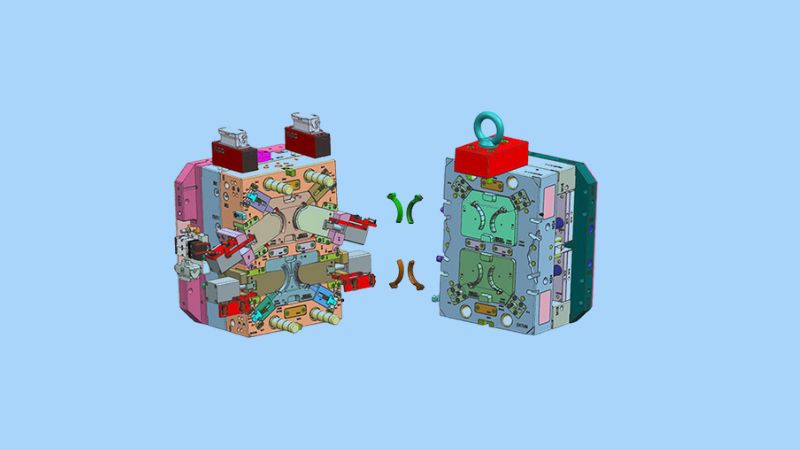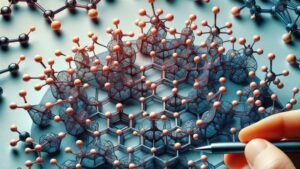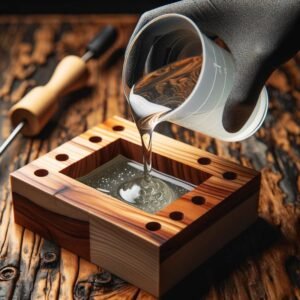Introduction
Brief Overview of Double Injection Molding
Double injection molding, often referred to as 2-shot or 2-material molding, stands as a pinnacle in modern plastic manufacturing. This technique enables the creation of parts with multiple colors or materials in a single molding cycle, fusing functionality with aesthetics.
Importance in Today’s Manufacturing Landscape
In the ever-evolving world of manufacturing, there is a constant demand for innovation and efficiency. Double injection molding not only meets this demand but elevates products by offering diverse material integrations, such as combining soft-touch surfaces with rigid structures. From consumer electronics to automotive parts, this technique’s imprint can be seen across industries, symbolizing its paramount importance in contemporary manufacturing.
Understanding Double Injection Molding
Definition and Basics
Double injection molding is a specialized plastic molding process where two distinct materials or colors are injected into a single mold, resulting in a unified component. This technique eliminates the need for secondary operations or assembly, allowing for intricate designs and material combinations to come to life seamlessly.
How the Process Works
The mechanics of this procedure are fascinating. Typically, a specialized molding machine with two or more injection units is utilized:
- The first material (which often forms the core or primary structure) is injected.
- Subsequently, the mold rotates or shifts to position this initial material for the second injection.
- The second material, which might be softer or of a different color, is then injected, bonding with the first material in the process.
- Once both injections are complete, the final integrated product is ejected.
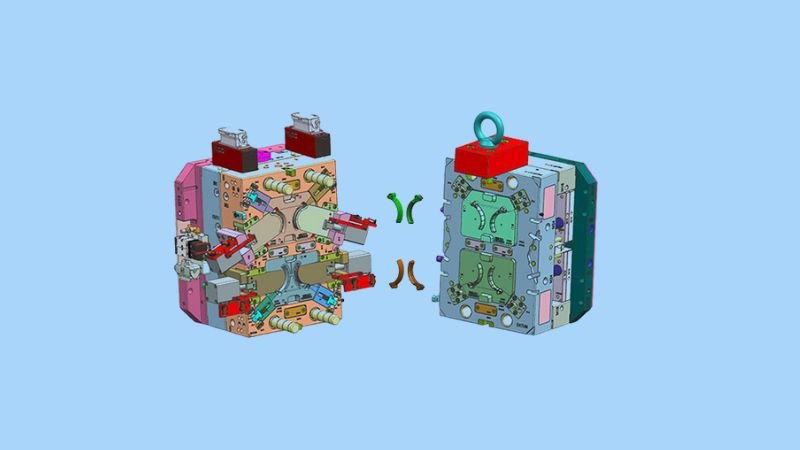
Key Advantages
Aesthetic Appeal
Through double injection molding, products can boast different colors, textures, or levels of transparency in specific areas, negating the requirement for additional painting or finishing.
Functionality
This technique allows parts to combine materials with diverse characteristics. For instance, a rigid structure can seamlessly incorporate soft-touch buttons or flexible regions, adding value to the final product.
Cost-Efficiency
Manufacturing a component in one mold reduces labor and assembly costs significantly when compared to traditional methods that might involve separate molding followed by assembly.
Types of Double Injection Molding
In the realm of double injection molding, various techniques have emerged to cater to specific product needs and design complexities. Each method brings its own set of advantages and suitable applications.
Rotary Double Injection Molding
This is perhaps the most common technique employed in the industry. Here:
- A rotating mold plate switches between two injection stations.
- The first material is injected at the first station.
- The mold plate then rotates to align with the second injection unit, where the second material is injected.
Applications: This method is particularly effective for products where precision in the alignment of both materials is crucial, such as buttons on electronic devices or multi-colored toys.
Stack Double Injection Molding
Employing a stacked mold design:
- Two molds are stacked vertically in the mold press.
- Both materials are injected simultaneously but into separate cavities.
- The finished part combines both materials, typically layered or stacked upon one another.
Applications: Ideal for products requiring layered material structures, such as certain types of seals, gaskets, or layered containers.
Side-by-Side Double Injection Molding
In this technique:
- The two materials are injected side-by-side in the same mold cavity.
- They merge at the boundary, resulting in a product where the materials exist side-by-side, without one enveloping the other.
Applications: Useful for products where different materials need to exist in parallel, like certain types of grips, handles, or multi-material panels.
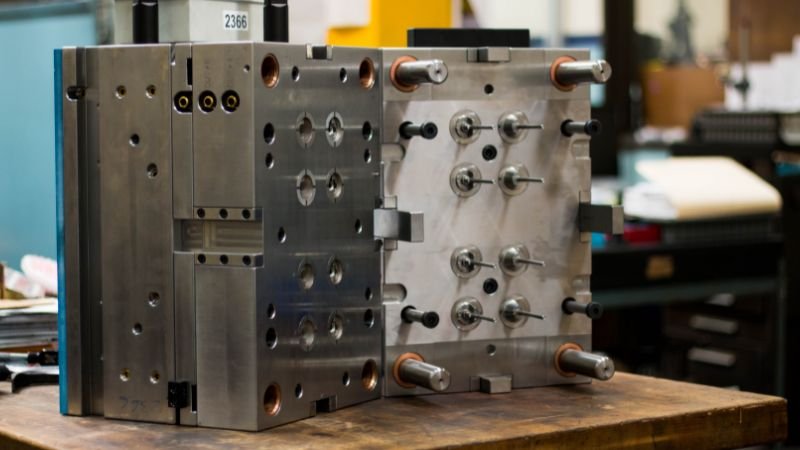
Design Considerations for Double Injection Molding
Successfully executing double injection molding requires meticulous design considerations. A well-thought-out design ensures efficiency, quality, and reduces the likelihood of errors during production.
Importance of Part Geometry
Understanding the geometry of the final part is pivotal. This includes:
- Shrinkage factors: Different materials might have varying shrinkage rates. It’s essential to account for these to prevent warping or misalignment.
- Overlapping regions: Designing the overlap between the two materials is crucial to ensure a strong bond and seamless finish.
Material Compatibility and Selection
Choosing materials that bond well is fundamental. Considerations include:
- Chemical compatibility: The two materials should not react adversely with each other, ensuring a lasting bond.
- Thermal compatibility: Materials should have similar melting temperatures to ensure simultaneous and even cooling.
- Mechanical bond: Even if materials don’t bond chemically, they should be designed to interlock mechanically.
Gate Design for Efficient Molding
The gate’s design, where the plastic enters the mold, affects the quality of the final product:
- Location: Proper positioning ensures even filling and reduces visible marks or blemishes.
- Size: A gate of appropriate size ensures efficient material flow without causing undue stress.
Ejection System Design: Ensuring Smooth Demolding
After the molding process:
- Smooth ejection: The part should be ejected smoothly to prevent deformities or damage.
- Ejection pin placement: Proper positioning prevents visible marks on the final product and ensures even ejection.
Manufacturing Process of Double Injection Molding
A precise and well-coordinated manufacturing process is pivotal to the success of double injection molding. Here’s a closer look at the step-by-step approach taken to achieve high-quality, integrated components.
Mold Design and Manufacturing
The cornerstone of the process:
- Complexity: Given the nature of double injection, molds are inherently more complex. They need to accommodate two materials and, often, multiple injection points.
- Durability: Molds must withstand high pressures and temperatures. Robust materials like hardened steel are often chosen for mold construction.
Material Preparation
Before molding, the chosen materials need preparation:
- Drying: Many plastics require pre-drying to remove moisture, ensuring a flawless finish.
- Mixing: If additives or colorants are required, they’re mixed with the base plastic to achieve the desired properties or hue.
Injection Molding Process
This is where the magic happens:
- First Injection: The primary material, forming the core or main structure, is injected into the mold.
- Mold Rotation/Shift: Once the first material is set, the mold shifts or rotates to accommodate the second material’s injection.
- Second Injection: The secondary material, usually complementing the first, is injected. It bonds with the first material, either chemically or mechanically.
- Cooling: The part is allowed to cool, solidifying its structure.
- Ejection: Once adequately cooled, the part is ejected from the mold, now fully integrated with both materials.
Quality Control
Ensuring each part meets the desired specifications:
- Visual Inspection: Parts are visually checked for any imperfections or inconsistencies.
- Dimensional Accuracy: Using precise measuring tools, the parts are checked against the desired dimensions.
- Functional Testing: If applicable, the parts might be tested for functionality, especially if they’re components of a more complex assembly.
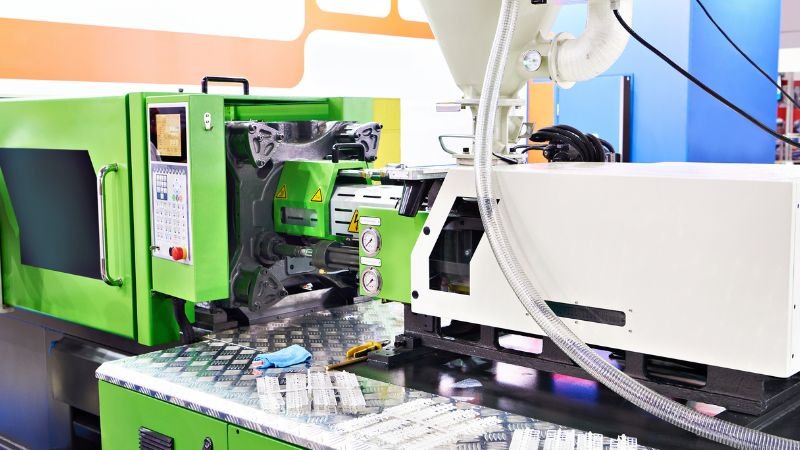
Applications and Industries Benefiting from Double Injection Molding
The versatility and precision of double injection molding have made it an invaluable asset to various industries. Let’s delve into some key sectors that have harnessed its potential to produce cutting-edge products.
Automotive Parts
In the modern vehicle, aesthetics meet functionality:
- Dashboard Components: Elements like buttons and knobs can have a rigid structure combined with soft-touch surfaces, enhancing user experience.
- Light Assemblies: Double injection allows for the integration of transparent and colored plastics, creating sophisticated light designs.
Consumer Electronics
Gadgets and devices we use daily often bear the mark of double injection:
- Smartphone Cases: Achieving a combination of rigidity (for protection) and soft or rubberized edges (for grip and aesthetics).
- Remote Controls: Integrating soft buttons with a rigid body, or even translucent buttons on a solid body.
Medical Devices
Safety and functionality are paramount:
- Surgical Tools: Devices that require a rigid structure but benefit from soft grips.
- Diagnostic Devices: Instruments with clear windows or flexible regions on rigid bodies, facilitating more effective patient diagnostics.
Packaging Products
From luxury to everyday items, packaging benefits immensely:
- Cosmetic Containers: Combining clear sections with colored or metallic finishes for a premium look.
- Food and Beverage: Bottles or containers that need a combination of rigidity with soft-seal caps.
Sporting Goods
For the modern athlete or enthusiast:
- Protective Gear: Helmets or guards that have a hard protective shell combined with a soft, cushioned interior.
- Footwear: Sports shoes with rigid soles integrated with soft, flexible upper materials or sections.
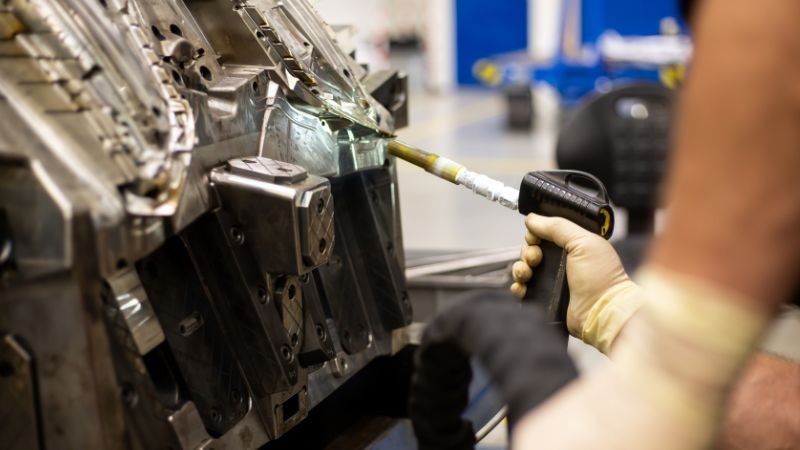
Troubleshooting and Common Challenges
Like any advanced manufacturing technique, double injection molding presents its set of challenges. Recognizing and resolving these issues is paramount to maintaining product quality and manufacturing efficiency.
Short Shot
- Issue: When one or both materials don’t completely fill the mold, resulting in an incomplete part.
- Solution: Check for proper material viscosity, increase injection pressure, or optimize gate locations.
Material Delamination
- Issue: The two materials separate or peel away from each other.
- Solution: Ensure the materials are compatible, check for contaminants, or adjust the processing temperature.
Sink Marks
- Issue: Indentations or depressions on the surface of the molded part.
- Solution: Adjust cooling rates, ensure even wall thickness in design, or modify injection pressure.
Flash
- Issue: Excess material that spills out of the mold, forming unwanted thin pieces on the part’s edges.
- Solution: Ensure the mold is properly aligned and clamped, inspect for wear and tear on the mold, or adjust material viscosity.
Jetting
- Issue: Visible wavy lines on the surface of the part, caused by the material “jetting” or shooting into the mold too fast.
- Solution: Adjust injection speed, reconsider gate location, or modify material temperature.
Bond Failure
- Issue: The two materials fail to bond adequately, leading to weak spots or separation.
- Solution: Ensure chemical and thermal compatibility of the materials, adjust processing temperatures, or modify mold design for better material flow.
Looking to the Future
The landscape of manufacturing is ever-evolving, and double injection molding is no exception. As industries seek more advanced and efficient solutions, this technique is poised for further growth and innovation.
Technological Advancements and Innovations
- Automation: Enhanced automation will likely play a significant role, ensuring more consistent results and faster production times.
- Material Science: The development of new polymers and blends can expand the possibilities of double injection molding, allowing for more diverse and advanced product applications.
- Simulation Software: Advanced mold-flow analysis and simulations can lead to better prediction of results, optimizing the process before actual production commences.
Market Trends
- Eco-Friendly Materials: With increasing emphasis on sustainability, the use of biodegradable or recycled materials in double injection molding may become more prevalent.
- Customization: As consumer demand for personalized products grows, double injection molding can cater to this trend by offering multi-material and multi-color customization options.
- Integration with Electronics: The convergence of plastics and electronics, such as embedded sensors or circuits within molded parts, could be a game-changer for many industries.
Challenges and Opportunities
- Environmental Concerns: As with all plastic processes, there’s a need for environmentally friendly practices, recycling, and waste reduction.
- Education and Training: The complexity of the process requires skilled labor. Investing in training and education can ensure the industry has the expertise needed to evolve.
Spotlight: Case Studies
Real-world applications often provide the most compelling evidence of a technique’s capabilities. By examining specific instances where double injection molding has been utilized, we can gain insights into its practical advantages and potential challenges.
Case Study 1: Smartphone Evolution
Background: As smartphones became essential devices, the demand for aesthetically pleasing yet functional designs skyrocketed.
Challenge: Manufacturers wanted to offer devices with rigid structures for durability, combined with soft-touch buttons and grips for user comfort.
Solution: Using double injection molding, a leading smartphone brand was able to combine a hard plastic frame with softer, rubberized edges and buttons. This not only enhanced the user experience but also reduced assembly steps and costs.
Outcome: A revolutionary smartphone design that set a new industry standard.
Case Study 2: Medical Diagnostic Tool
Background: A medical company aimed to produce a blood glucose meter with a clear window for display and a comfortable grip for patients.
Challenge: The device needed to be user-friendly, durable, and allow for clear readings.
Solution: Double injection molding was employed to integrate a clear, rigid plastic window with a softer, ergonomic grip in a single molding process.
Outcome: A product that was both functional and patient-centric, leading to increased market share for the company.
Case Study 3: Sports Footwear
Background: A renowned sports brand wanted to innovate its line of running shoes, aiming for a balance between performance and comfort.
Challenge: The shoes required a firm sole for support, combined with flexible and breathable upper sections.
Solution: With double injection molding, the brand was able to mold a rigid sole with integrated softer sections for ventilation and flexibility.
Outcome: A groundbreaking shoe design that received acclaim from both athletes and casual users, leading to significant sales growth.
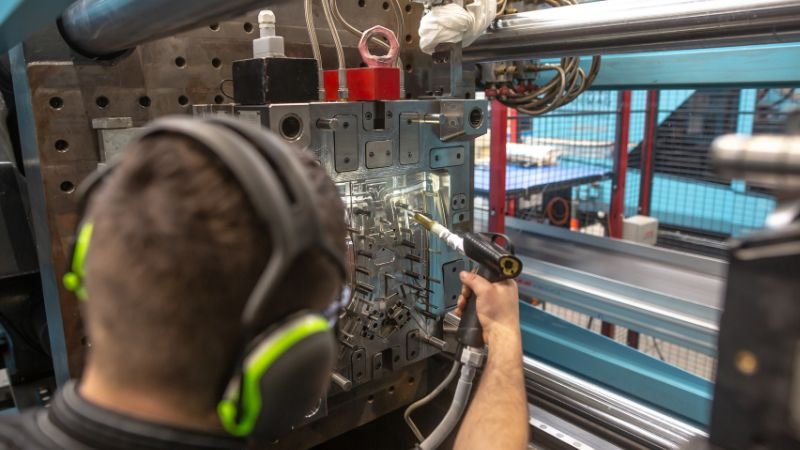
Glossary and Key Terms
For those unfamiliar with some of the terminology associated with double injection molding, this glossary serves as a quick reference guide.
- 2-Shot Molding: Another term for double injection molding, signifying the two-stage injection process.
- Bi-Injection: Yet another term used synonymously with double injection molding.
- Cavity: The hollow space in the mold where the plastic is injected and takes the shape of the desired part.
- Delamination: When the two materials in a double injection molded part separate from each other.
- Ejector Pins: Rods or pins that push the molded part out of the mold once it’s cooled and solidified.
- Flash: Excess material that leaks out of the mold, forming thin undesired edges on the part.
- Gate: The point where the molten plastic enters the mold.
- Mold Flow Analysis: A simulation used to predict how the plastic will fill the mold, ensuring optimal design and material flow.
- Overmolding: A variant of double injection molding where a second layer of material is molded over a pre-existing part.
- Short Shot: When the mold isn’t fully filled with plastic, leading to an incomplete part.
- Thermal Compatibility: The ability of two materials to bond based on their similar melting or processing temperatures.
Conclusion
The journey through double injection molding has highlighted its transformative impact across industries, from consumer electronics to healthcare. This intricate yet efficient process fuses aesthetics with functionality, enabling product innovations that were once deemed challenging or even impossible.
Recapping the Significance
- Innovation Catalyst: Double injection molding has spurred industries to rethink design paradigms, pushing the boundaries of what’s achievable with plastics.
- Efficiency Meets Aesthetics: Beyond just merging two materials, the technique paves the way for cost-effective production without compromising on visual appeal or functionality.
- Future-Forward: As industries continue to evolve, so will double injection molding, adapting to new challenges and innovating in tandem with technological advancements.
Encouragement to the Readers
For those involved in product design, manufacturing, or simply enthusiasts of engineering marvels, double injection molding offers a treasure trove of possibilities. By staying curious and open to experimentation, the next big innovation could be just a mold away.
Double injection molding stands as a testament to human ingenuity, exemplifying how challenges can be turned into opportunities. As we look ahead, this technique will undoubtedly continue to shape the world of manufacturing, one mold at a time.

